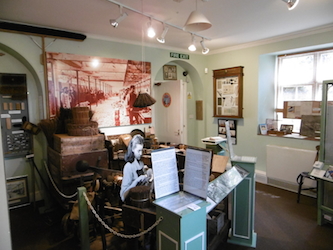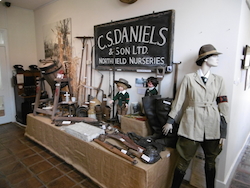Housed in a mid 18th century former prison near the centre of the town the Wymondham Heritage Museum opened in 1996 when it moved from a “garden shed” in the car park of the local council offices. There are just over 2,400 items in the collection; a somewhat eclectic mix covering a wide range of themes which tell the social, historical, geographical and industrial story of the town and the local area. The building, “The Bridewell”, is in itself of historical significance being the first “Model Prison” where prisoners each had their own cell. Due for development, it was purchased by the Wymondham Society who raised funds to convert it to contain a charity shop, fourteen housing association flats and the museum, which includes a small tearoom and shop in the reception area. The building is managed and owned by the Bridewell Preservation Trust to whom we pay rent and an annual service charge. From our income we also have to pay our running costs, utilities, repairs, decoration and other maintenance as well as the costs of keeping the displays and collection up to date and in good order. We are accredited, due for renewal in 2015 as is the lease on the building.
So who is our staff? We have about 160 volunteers. We are open 10am to 4pm Monday to Saturday from March to October. Almost all of our volunteers are retired, (some in their mid 80’s) and most of them “work” 3 hours a month, i.e. a morning or afternoon shift on a regular rota, say the second Wednesday morning of the month. To manage the “business” there is a small committee of seven each with a number of responsibilities and tasks. The present chairman, for instance, is the accessions officer, helps with technical maintenance, sets up new displays, produces publicity and attends the governing body trustees monthly meetings and meetings of the Museums in Norfolk Group (MiNG), a local consortium of small local museums.

What about our visitors? We average about 2000 a year, although this year, due to a targeted World War One display our monthly average is up. We have the usual visitor response sheet, which is completed by approximately 30% of visitors, so we know where they come from, how they found us and what they think. As part of our forward plan we are trying to increase the number of visitors from the local area; at the moment only 15% of our visitors come from locally. We do have some group visits. Social groups, WI’s, youth groups and local history groups all add to our numbers. There is no computer in the museum so our entry system is paper based, but it is perfectly effective.
Marketing the museum is an ongoing activity. We distribute some 2,500 leaflets a year to local libraries, visitor centres and hotels. We have good links with the local press, ensuring presence at special events, and a number of local publications advertising events and activities give us a regular voice. We have just introduced Pop in Late for a Pound for the last 45 minutes of opening time, although some visitors are happy to pay full price. We also have season tickets and at various events in the town we sell “advanced entry tickets”. We’re just putting a toe in the water of social media but our website manager keeps us up to date. From our visitor analysis in 2013, 12% of our visitors were “just walking by”! Within the museum, we are slowly updating our images to give more clarity and increase the attention visitors give to the information. We have lively debates as to what to put in or take out; our enthusiasm for wanting to tell our visitors ALL about a topic has to be contained.

Lighting is a problem. We are one of those small museums where lighting that is old is still functioning – we are aware that where possible we need to change to low energy units, but rewiring a Grade 2 listed building to update a system in place since the 1980’s would require significant expenditure. What grants might be available for such a project have not yet been explored. At the moment the policy is “If it ain’t broke, don’t fix it”.
Meeting our financial commitments can be challenging. Our museum income averages £6,000 a year and our “bills” about £8,500 so we need support from events such as Open Gardens, second hand book sales and a 200 Club. One always has to plan to cover unexpected costs, e.g. paying £210 to BT for repairing telephone lines eaten by mice. The shop, tearoom and second hand book shelf give us a steady income. Average spend per visit in 2013 was 66p. The shop is located in the reception area and is staffed by two volunteers. The tearoom is open to non-museum visitors and relies on volunteers providing the cakes and scones which are the staple menu. Both break even each year – just.
One of the greatest challenges is running a museum with a staff entirely made up of volunteers, including the management team. There has been a significant shift in the nature of volunteering over the past 15 to 20 years, with a wide range of volunteer-run organisations increasingly finding difficulty in recruiting both numbers and the skills needed. In our town there are at least 8 or 9 groups who need to replace key workers to ensure their group continues to function. The age range of our committee is from 81 to 54, some of whom have been in post since the museum opened in 1996!
So there you have it: life at the front line of a Great Small Museum. Whilst I read of tens of thousands of visitors, layers of professional staff and million pound budgets, we soldier on delivering what we think is a good service to visitors who seem to enjoy what we offer. Always remember “When you are up to you’re armpits in crocodiles the aim is to drain the swamp”.
Back to top




